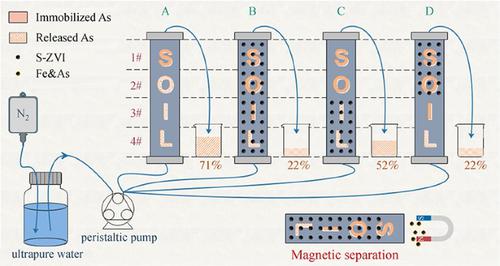Frontiers of Environmental Science & Engineering ( IF 6.1 ) Pub Date : 2020-12-20 , DOI: 10.1007/s11783-020-1377-z Junlian Qiao , Yang Liu , Hongyi Yang , Xiaohong Guan , Yuankui Sun

|
In this study, the influences of sulfidation on zero-valent iron (ZVI) performance toward As(V) immobilization in soil were systemically investigated. It was found that, compared to unamended ZVI, sulfidated ZVI (S-ZVI) is more favorable to immobilize As(V) in soil and promote the conversion of water soluble As to less mobile Fe-Mn bound As. Specifically, under the optimal S/Fe molar ratio of 0.05, almost all of the leached As could be sequestrated by > 0.5 wt.% S-ZVI within 3 h. Although the presence of HA could decrease the desorption of As from soil, HA inhibited the reactivity of S-ZVI to a greater extent. Column experiments further proved the feasibility of applying S-ZVI on soil As(V) immobilization. More importantly, to achieve a good As retention performance, S-ZVI should be fully mixed with soil or located on the downstream side of As migration. The test simulating the flooding conditions in rice culture revealed there was also a good long-term stability of soil As(V) after S-ZVI remediation, where only 0.7% of As was desorbed after 30 days of incubation. Magnetic separation was employed to separate the immobilized As(V) from soil after S-ZVI amendment, where the separation efficiency was found to be dependent of the iron dosage, liquid to soil ratio, and reaction time. Toxicity characteristic leaching procedure (TCLP) tests revealed that the leachability of As from soil was significantly reduced after the S-ZVI amendment and magnetic separation treatment. All these findings provided some insights into the remediation of As(V)-polluted soil by ZVI.
中文翻译:

硫化零价铁对砷污染土壤的修复
在这项研究中,系统地研究了硫化对零价铁(ZVI)对土壤中As(V)固定化性能的影响。已发现,与未改性的ZVI相比,硫化的ZVI(S-ZVI)更有利于将As(V)固定在土壤中,并促进水溶性As转化为流动性较低的Fe-Mn结合As。具体地,在0.05的最佳S / Fe摩尔比下,几乎所有浸出的As可以在3小时内被螯合> 0.5wt。%的S-ZVI。尽管HA的存在可以减少As从土壤中的解吸,但是HA在更大程度上抑制了S-ZVI的反应性。柱实验进一步证明了将S-ZVI应用于土壤As(V)固定化的可行性。更重要的是,要获得良好的As保留性能,S-ZVI应与土壤充分混合或位于As迁移的下游。模拟水稻培养中的洪水条件的测试表明,在S-ZVI修复后,土壤As(V)也具有良好的长期稳定性,在温育30天后仅解吸了0.7%的As。S-ZVI改性后,采用磁分离法从土壤中分离出固定化的As(V),分离效率取决于铁的添加量,液土比和反应时间。毒性特征浸出程序(TCLP)测试表明,S-ZVI改性和磁选处理后,As从土壤中的浸出性显着降低。所有这些发现为ZVI修复As(V)污染土壤提供了一些见识。模拟水稻培养中的洪水条件的测试表明,在S-ZVI修复后,土壤As(V)也具有良好的长期稳定性,在温育30天后仅解吸了0.7%的As。S-ZVI改性后,采用磁分离法从土壤中分离出固定化的As(V),分离效率取决于铁的添加量,液土比和反应时间。毒性特征浸出程序(TCLP)测试表明,S-ZVI改性和磁选处理后,As从土壤中的浸出性显着降低。所有这些发现为ZVI修复As(V)污染土壤提供了一些见识。模拟水稻培养中的洪水条件的测试表明,在S-ZVI修复后,土壤As(V)也具有良好的长期稳定性,在温育30天后仅解吸了0.7%的As。S-ZVI改性后,采用磁分离法从土壤中分离出固定化的As(V),分离效率取决于铁的添加量,液土比和反应时间。毒性特征浸出程序(TCLP)测试表明,S-ZVI改性和磁选处理后,As从土壤中的浸出性显着降低。所有这些发现为ZVI修复As(V)污染土壤提供了一些见识。孵育30天后,有7%的As解吸。S-ZVI改性后,采用磁分离法从土壤中分离出固定化的As(V),分离效率取决于铁的添加量,液土比和反应时间。毒性特征浸出程序(TCLP)测试表明,S-ZVI改性和磁选处理后,As从土壤中的浸出性显着降低。所有这些发现为ZVI修复As(V)污染土壤提供了一些见识。孵育30天后,有7%的As解吸。S-ZVI改性后,采用磁分离法从土壤中分离出固定化的As(V),分离效率取决于铁的添加量,液土比和反应时间。毒性特征浸出程序(TCLP)测试表明,S-ZVI改性和磁选处理后,As从土壤中的浸出性显着降低。所有这些发现为ZVI修复As(V)污染土壤提供了一些见识。毒性特征浸出程序(TCLP)测试表明,S-ZVI改性和磁选处理后,As从土壤中的浸出性显着降低。所有这些发现为ZVI修复As(V)污染土壤提供了一些见识。毒性特征浸出程序(TCLP)测试表明,S-ZVI改性和磁选处理后,As从土壤中的浸出性显着降低。所有这些发现为ZVI修复As(V)污染土壤提供了一些见识。











































 京公网安备 11010802027423号
京公网安备 11010802027423号